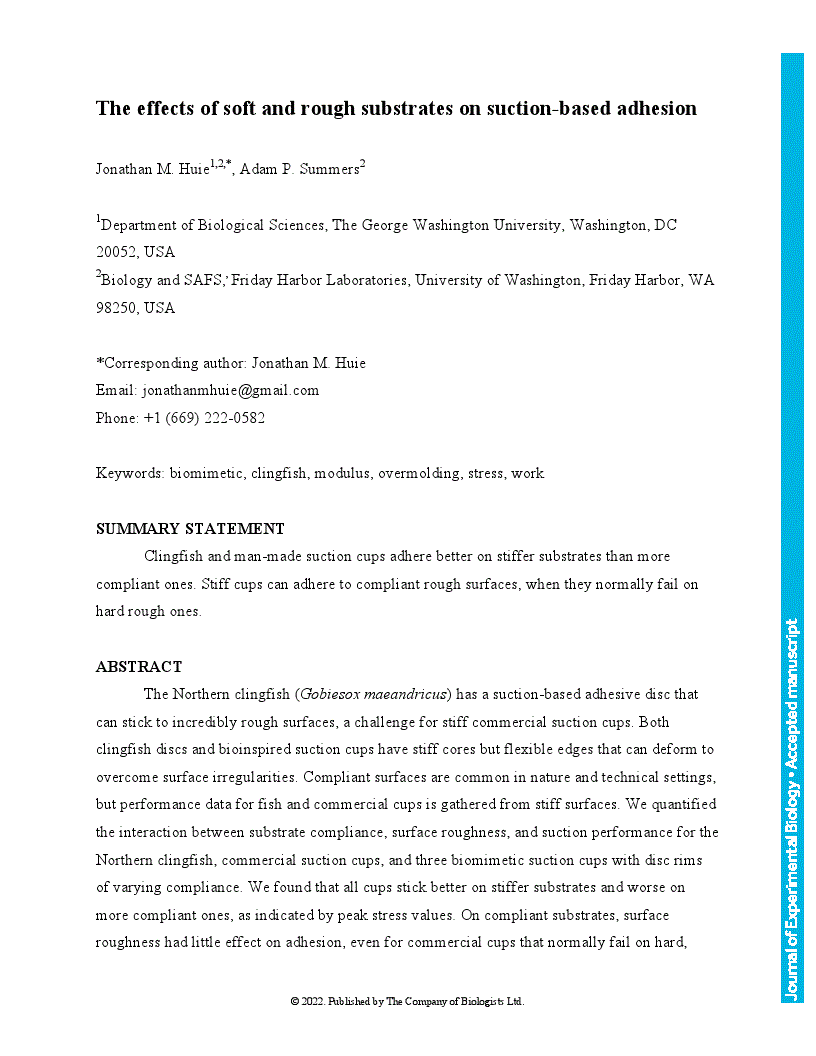The Northern clingfish (Gobiesox maeandricus) has a suction-based adhesive disc that can stick to incredibly rough surfaces, a challenge for stiff commercial suction cups. Both clingfish discs and bioinspired suction cups have stiff cores but flexible edges that can deform to overcome surface irregularities. Compliant surfaces are common in nature and technical settings, but performance data for fish and commercial cups is gathered from stiff surfaces. We quantified the interaction between substrate compliance, surface roughness, and suction performance for the Northern clingfish, commercial suction cups, and three biomimetic suction cups with disc rims of varying compliance. We found that all cups stick better on stiffer substrates and worse on more compliant ones, as indicated by peak stress values. On compliant substrates, surface roughness had little effect on adhesion, even for commercial cups that normally fail on hard, rough surfaces. We propose that suction performance on compliant substrates can be explained in part by effective elastic modulus, the combined elastic modulus from a cup-substrate interaction. Of all the tested cups, the biomimetic cups performed the best on compliant surfaces, highlighting their potential to be used in medical and marine geotechnical fields. Lastly, we discuss the overmolding technique used to generate the bioinspired cups and how it is an important tool for studying biology.
The effects of soft and rough substrates on suction-based adhesion
- Award Group:
- Funder(s): National Science Foundation
- Award Id(s): DEB-1701665
- Funder(s):
- Award Group:
- Funder(s): Seaver Institute
- Funder(s):
Currently Viewing Accepted Manuscript - Newer Version Available
- Split-screen
- Views Icon Views
- Open the PDF for in another window
-
Article Versions Icon
Versions
- Version of Record 12 May 2022
- Accepted Manuscript 25 April 2022
- Share Icon Share
-
Tools Icon
Tools
- Search Site
Jonathan M. Huie, Adam P. Summers; The effects of soft and rough substrates on suction-based adhesion. J Exp Biol 2022; jeb.243773. doi: https://doi.org/10.1242/jeb.243773
Download citation file:
Advertisement
2023 JEB Outstanding Paper Prize shortlist and winner

The JEB Editors are delighted to announce the shortlisted authors for the 2023 JEB Outstanding Paper Prize. Read the winning paper - Tiny spies: mosquito antennae are sensitive sensors for eavesdropping on frog calls - by Hoover Pantoja-Sanchez and Brian Leavell from Ximena Bernal's lab at Purdue University, USA.
JEB Science Communication Workshop for ECRs

If you’re an early-career researcher interested in science communication and are attending the SEB Annual Conference in Prague this summer, come a day early and join the JEB Editors at a sci comm workshop to learn the key writing skills needed to promote your research to a broad audience beyond your peers (1 July at 14.30-17.30). Places are limited to 24 attendees, and applicants should apply through the SEB registration page by 30 April 2024.
Bridging the gap between controlled conditions and natural habitats in understanding behaviour

Novel technologies enable behavioural experiments with non-model species, in naturalistic habitats and with underexplored behaviours. In their Commentary, Scholz and colleagues discuss how to obtain a deeper understanding of the natural ecology and lifestyle of study animals.
Beluga metabolic measures could help save species

To help save animals from extinction, it’s important to understand what each species needs to survive. This led Jason John et al. to measure the metabolic rates of captive belugas to develop a ‘fish calculator’ showing that the whales need to eat ~23 salmon per day.
ECR Workshop on Positive Peer Review

Are you an ECR looking for tips on how to write concise, astute and useful manuscript reviews? If so, join the JEB Editors at a 2-hour JEB-sponsored Workshop on Positive Peer Review at the Canadian Society of Zoologists annual meeting in Moncton on 9 May 2024 at 13.00-15.00. There are 25 spaces for ECRs and selection is first come, first serve. To sign up, check the ECR Workshop box when you register for the CSZ meeting.



